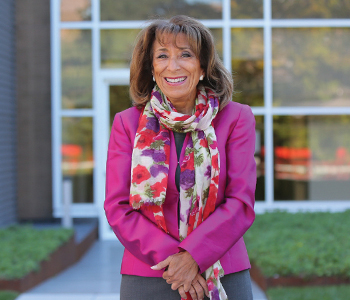A Model of Care for Aging

Dr. Bindhu K. Thomas
America’s rapidly aging population is no more evident than in the growing geriatric outpatient practice at NewYork-Presbyterian Hospital/Columbia University Irving Medical Center, where the average age is 87 years old and geriatrician Bindhu K. Thomas, MD, sees about two new patients per day. The practice is an excellent training ground for internal medicine interns as the team expertly navigates the complexities of multiple geriatric syndromes and chronic conditions, polypharmacy, and challenges related to medication adherence.
“The population is aging rapidly in this area. Because of the complexity of care, a lot of primary doctors are sending their older patients to see a geriatrician,” says Dr. Thomas, who notes that some patients are travelling as far as two hours to see a doctor in the Division of Geriatric Medicine and Aging at NewYork-Presbyterian Allen Hospital. “The practice is growing,” says Debbie Smyth, GNP, the program’s geriatric nurse practitioner. “It is a combination of baby boomers and new people hearing about the program.”
Multidisciplinary Care

Dr. Evelyn C. Granieri
With many patients in their nineties or hundreds – the oldest being 104 years of age – the team is focused on preventing and managing common geriatric syndromes while simultaneously managing comorbid chronic conditions. A high level of coordination among inpatient and outpatient geriatricians and nurse practitioners is paramount. “Dr. Thomas and Ms. Smyth are models of the best clinical geriatrics care possible. Their expertise in addressing frail and vulnerable older adults’ needs are without equal,” says Evelyn C. Granieri, MD, MPH, MSEd, Chief, Division of Geriatric Medicine and Aging, NewYork-Presbyterian/Columbia.
“Dr. Thomas and Ms. Smyth are models of the best clinical geriatrics care possible. Their expertise in addressing frail and vulnerable older adults’ needs is without equal.”
— Dr. Evelyn C. Granieri
The group administers careful assessments and delivers comprehensive care. “We assess patients for frailty and falls, as well as geriatric syndromes because one plays off of another — for example incontinence and falling,” says Dr. Thomas, who is one of four geriatricians at NewYork-Presbyterian/Columbia. Dr. Thomas typically sees 13 patients per day with each new patient appointment lasting about 1.5 hours – lengthy when compared to a 15-minute internal medicine new patient private office visit.
“It is not the algorithm of care that we learned in medical school,” says Dr. Thomas. “My hypertension treatment will be totally different in a 70-year-old than an 80-year-old because it’s not good for them to be on such tight control,” explains Dr. Thomas.
Medical Education
Four internal medicine interns rotate for one month with the geriatric team at NewYork-Presbyterian/Columbia, breaking out into two-week increments. “The interns shadow us in both inpatient and outpatient rotations. We go over assessments, what to look for in dementia, medications, and how to discuss advanced care planning,” says Dr. Thomas.
House visits are a large part of the teaching curriculum for first year residents. Ms. Smyth spearheads the geriatric house call program, leading interns through house calls twice per month. “When Columbia interns rotate with us, they spend one month learning about geriatrics. No matter what they decide to specialize in, unless it’s pediatric or OB, they will always take care of geriatric patients, so we try to incorporate some geriatric pearls into their intern ear,” says Ms. Smyth.
First year residents are often able to experience new patient home safety evaluations or post-discharge follow-ups during their rotation. “It is a really great opportunity for the interns to see another aspect of patient care. It is very different than the office and gives us an opportunity to do safety evaluations, order durable medical equipment, look at social support in the home, and make referrals as needed,” says Ms. Smyth, who has left some home visits with a bag of expired prescription and over-the-counter medications.
Medication Adherence and Polypharmacy
Medication adherence and polypharmacy continue to be a major challenge for geriatricians across the country. It is no different at NewYork-Presbyterian Allen Hospital. “We see bottles from years ago, different prescribers, or all medications in one bottle,” says Dr. Thomas.
With the growing number of older adults with multiple comorbid health conditions, healthcare expenditures are predicted to soar. Many experts are calling for the need for more streamlined and efficient care. “Aging people are not going anywhere. There are only becoming more of them. Cutting back on redundant tests, inappropriate testing, and medications will affect the bottom line,” says Dr. Granieri.
“The most important thing we do is ask patients to bring all of their medications to each visit and try to take away unnecessary ones.”
— Dr. Bindhu K. Thomas
“The most important thing we do is ask patients to bring all of their medications to each visit and try to take away unnecessary ones. There is a lot of marketing with multivitamins and often senior citizens are unnecessarily taking a multivitamin plus vitamin B and vitamin C. That alone cuts out 3 pills,” says Dr. Thomas.
Supervision by caregivers is optimal, but social and familial issues often take center stage and impede doctors’ best efforts at medication adherence. The majority of patients in the Division of Geriatric Medicine and Aging practice are frail, vulnerable, living at home with little or no social support, and have challenges related to limited English proficiency and low socioeconomic status. “Social issues are rampant and often family members are not in touch or not caring for patients,” says Dr. Thomas.
To combat polypharmacy and challenges related to medication adherence, the geriatric team employs several strategies including partnering with pharmacies in the community, pre-pouring pill boxes, using blister packs, and caregiver supervision whenever possible.



